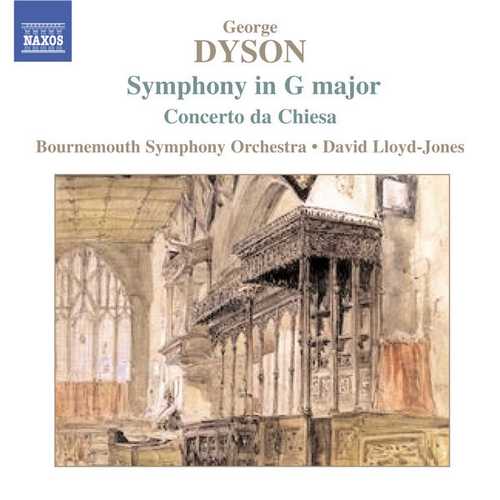
Composer: George Dyson
Performer: Stuart Green, Duncan Riddell, Helen Cox, Timothy Walden
Orchestra: Bournemouth Symphony Orchestra
Conductor: David Lloyd-Jones
Format: FLAC (tracks)
Label: Naxos
Release: 2005
Size: 508 MB
Recovery: +3%
Scan: yes
01. At the Tabard Inn – Overture
Concerto da Chiesa
02. I. Veni, Emmanuel
03. II. Corde natus
04. III. Laetatus sum
Symphony in G
05. I. Energico
06. II. Andante
07. III. Allegro risoluto – L’istesso tempo – Molto moderato – Vivace – Molto sostenuto – Poco andante – Poco allegretto – Presto – Grazioso
08. IV. Poco adagio – Andante – Allegro assai – Andante molto moderato
Acclaimed at its first performance in 1937, Dyson’s ambitious Symphony subsequently fell into neglect as it followed on from a striking sequence of symphonies written by British composers in the 1930s such as Vaughan Williams, Walton, Bax and Moeran. In the first two movements, Dyson’s determination to strike a contemporary pose in an era symphonically dedicated to Sibelius seems to inhibit his natural melodic gift, with often fragmentary thematic material rarely developing into a tune.
Yet in the third-movement variations – taking the place of a scherzo – and most of all in the colourful finale, any inhibitions evaporate in warm, free and colourful writing, echoing that in Dyson’s Chaucerian choral work The CanterburyPilgrims. Helped by a clear, well-balanced recording, David Lloyd-Jones conducts a brilliant performance that clarifies textures noticeably.
Each of the three movements of the Concerto dachiesa for strings of 1949 is based on a medieval hymn melody, with Veni Emmanuel inspiring a darkly dedicated slow first movement. It is among Dyson’s finest inspirations, a lament no doubt reflecting his mood after the Second World War.
That melody returns transformed at the end of the joyful finale, which is based on the vigorous psalm tune Laetatus sum. The central Allegretto uses the carol-like Corde natus for lightly scored and fanciful variations. As in Elgar’s Introductionand Allegro and Vaughan Williams’s Tallis Fantasia, solo strings are beautifully and atmospherically set against the full string band, enhanced here by fine separation in the Naxos recording.
Originally designed to introduce The CanterburyPilgrims, the overture At the Tabard Inn makes an attractive addition to a well-filled disc. All three works are superbly played and vividly recorded.